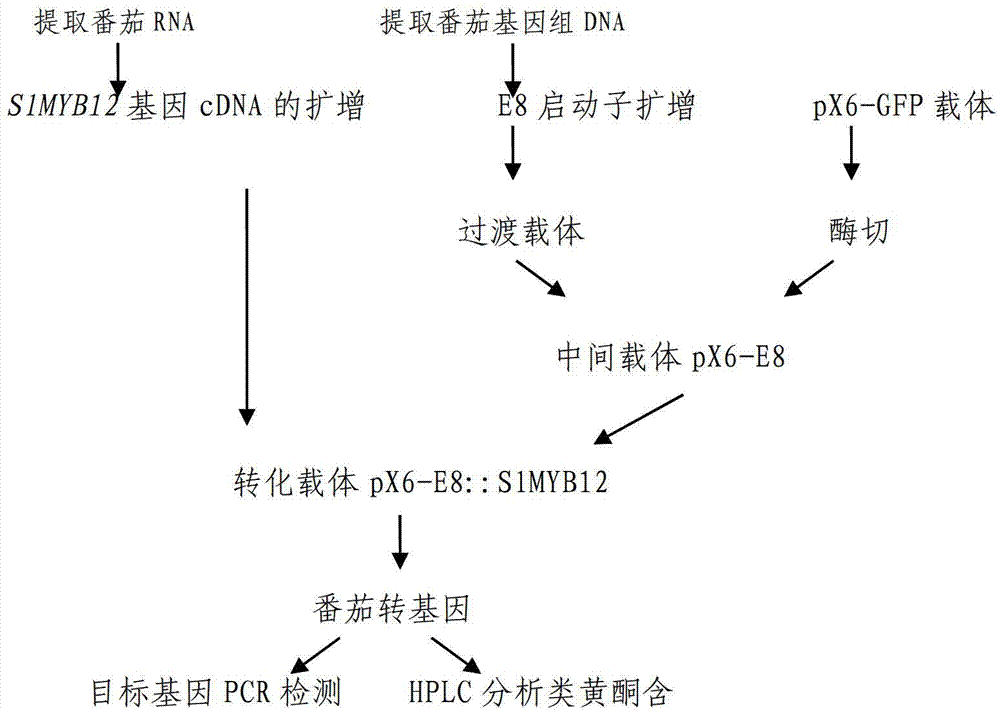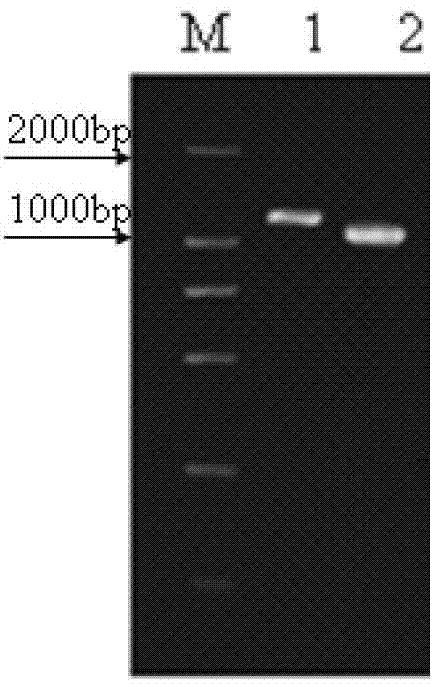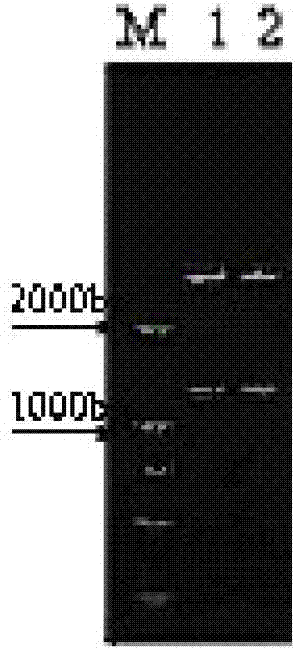Gene segment for regulating synthesis of solanaceae flavonoids and caffeoyl quinic acid, and uses thereof
A technology of caffeoylquinic acid and gene fragments, which is applied in the fields of application, genetic engineering, plant genetic improvement, etc.
- Summary
- Abstract
- Description
- Claims
- Application Information
AI Technical Summary
Problems solved by technology
Method used
Image
Examples
Embodiment 1
[0043] Cloning of embodiment 1 fruit-specific E8 promoter and SlMYB12 gene full-length cDNA, construction of plant expression vector:
[0044] 1. Cloning of Tomato Fruit-Specific E8 Promoter and S1MYB12 Gene cDNA
[0045] Using the genome DNA of tomato variety Zhongshu No. 4 as a template, primers E8PF1, whose gene sequence is shown in SEQ ID NO: 4, and E8PR1, whose gene sequence is shown in SEQ ID NO: 5, were amplified in combination to obtain the expected 1.1kb fragment ( figure 2 shown). Furthermore, the combined amplification product of E8PF1 / R1 was cloned by TA, and connected to the PCR product cloning vector pGEM-T Easy vector. Transform Escherichia coli DH5α to obtain a large number of clones. The 12 randomly selected clones were identified by colony PCR using the specific primer combination E8PF1 / R1, and 8 clones with the target fragment insertion were obtained. Two clones were randomly selected to extract plasmids and verified by EcoR I digestion to confirm that...
Embodiment 2
[0053] Example 2 Agrobacterium-mediated tomato genetic transformation and PCR detection of transgenic plants
[0054] 1. Genetic transformation of tomato mediated by Agrobacterium
[0055] Using tomato cotyledons as explants, the plant expression vector pX6-E8::SlMYB12 was transformed into Micro-Tom, CSl09-03, and cherry tomatoes by Agrobacterium (AGL I strain)-mediated leaf disk transformation method. body material. All operations are carried out in a strict aseptic environment, and the basic procedures for transgenic operations are as follows:
[0056] 1) The seeds were sterilized with 75% ethanol for 1 min, treated with 2% NaOCl available chlorine for 15 min, washed 4-5 times with sterile distilled water, sowed in 1 / 2MS medium with appropriate spacing, and then transferred to Cultivate under 16h light / 8h dark until the cotyledons are fully unfolded.
[0057] 2) Cut off the front and back sections of the cotyledon with a blade, and take a leaf about 0.5 cm in the middle,...
Embodiment 3
[0065] Example 3 HPLC analysis of tomato fruit flavonoids and caffeoylquinic acid content
[0066]There was no significant difference between transgenic tomato and non-transgenic plants in the vegetative growth period. During the reproductive growth period, the fruit shape of a few lines changed, and the umbilical tip and fruit swelled (mainly occurred in Micro-Tom grown in natural light greenhouses). From the discoloration stage, the skin of the transgenic fruit gradually tends to orange red or dark yellow, while the control fruit still maintains the corresponding red (Micro-Tom, CSL09-03) or light yellow (cherry tomato), Micro-Tom, CSl09-03 background The color of the transgenic fruit pulp was only slightly changed, and the cherry tomato was not obvious. The follow-up HPLC analysis proved that the color change of the transgenic fruit was related to the increase of flavonoid substances such as rutin and the content of caffeoylquinic acid ( Figure 8 , Figure 9 , Figure 10...
PUM
 Login to View More
Login to View More Abstract
Description
Claims
Application Information
 Login to View More
Login to View More - R&D
- Intellectual Property
- Life Sciences
- Materials
- Tech Scout
- Unparalleled Data Quality
- Higher Quality Content
- 60% Fewer Hallucinations
Browse by: Latest US Patents, China's latest patents, Technical Efficacy Thesaurus, Application Domain, Technology Topic, Popular Technical Reports.
© 2025 PatSnap. All rights reserved.Legal|Privacy policy|Modern Slavery Act Transparency Statement|Sitemap|About US| Contact US: help@patsnap.com



